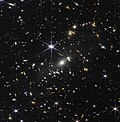| JADES-GS-z13-0 | |
|---|---|
 James Webb Space Telescope NIRCam color composite image of JADES-GS-z13-0 | |
| Observation data (J2000 epoch) | |
| Constellation | Fornax |
| Right ascension | 03h 32m 35.97s [1] : 5 |
| Declination | −27° 46′ 35.4″ [1] : 5 |
| Redshift | 13.20+0.04 −0.07 [1] : 5 |
| Distance |
|
| Apparent magnitude (V) | 29.43±0.14 AB (F200W) [1] : 5 |
| Absolute magnitude (V) | −18.73±0.06 (UV) [3] : 6 |
| Characteristics | |
| Mass | 8.91+4.89 −4.34×107 [1] : 5 M☉ |
| Other designations | |
| JADES-GS+53.1499–27.7765, [1] DMM2023 UDF-22450 | |
JADES-GS-z13-0 is a high-redshift Lyman-break galaxy discovered by the James Webb Space Telescope (JWST) during NIRCam imaging for the JWST Advanced Deep Extragalactic Survey (JADES) on 29 September 2022. Spectroscopic observations by JWST's NIRSpec instrument in October 2022 confirmed the galaxy's redshift of z = 13.2 to a high accuracy, establishing it as the oldest and most distant spectroscopically-confirmed galaxy at the time, with a light-travel distance (lookback time) of 13.4 billion years. [4] [3] Because of the expansion of the universe, its present proper distance is approximately 33 billion light-years. [5] In 2024, two older and more distant galaxies, JADES-GS-z14-0 and JADES-GS-z14-1, were found. [6]
JADES-GS-z13-0 is located in the Great Observatories Origins Deep Survey – South (GOODS-S) field in the constellation Fornax, which includes the Hubble Ultra Deep Field. [1] [7]




